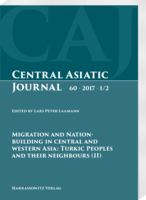|
|
Download:
The Central Asiatic Journal is devoted to the linguistic, cultural, and historical heritage of Central Asia. Most contributions relate to the geographical remit of the Central Asian core region, i.e. Mongolia, Turkestan/Xinjiang, Tibet, Siberia, and Manchuria. By extension, however, this definition can include a secondary sphere extending into all of western Asia, the Himalayas, China’s Han-majority provinces and the Pacific fringe region (Korea, Japan, and eastern Siberia). Articles are published in English, German, French, Russian, and Chinese. The Central Asiatic Journal is fully peer-reviewed.
The journal has started publishing contributions in thematic clusters, and after focuses on Mongolia, its surrounding regions and the historical implications of Mongolian expansion in issue 56 (2012/2013), and on the Tangut people and the Xi-Xia (His-Hsia) state in issue 57 (2014), the focus in issue 58 is on the contribution of the Manchus to China’s more recent history. The latest issue 59 (2016) is focused on the migration and nation-building in central and western Asia. From the Contents (altogether 24 contributions): Jingyi Gao, Xia and Ket Identified by Sinitic and Yeniseian. Shared Etymologies Şerife Özer, Neologistische Wortbildung des Türkeitürkischen im Urteil der traditionellen Sprachwissenschaft Erdem Ucar, Notizen zur Etymologie des alttürkischen özäl- ‘sich quälen’ Pei-lin Wu, Aesop’s Fables in Ancient China Michael Hope, Some remarks about the use of the term ‘īlkhān’ in the historical sources and modern historiography Michael Knüppel, Versuch einer Genealogie des Herrscherhauses der Kerait Gulchekhra Sultonova, Bukharan Relations with the Zunghar Khanate in the Early Modern Era - New Sources and New Insights |






